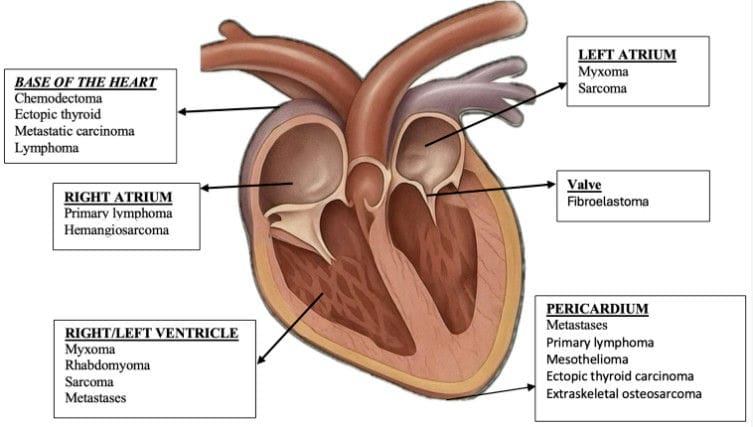- Veterinary View Box
- Posts
- Review of canine cardiac tumors.....
Review of canine cardiac tumors.....
Life 2025
Nicoleta Andreea Mincă, Ionuț Cătălin Dumbravă, Niculae Tudor, Alina Ștefănescu, Alexandru Bogdan Vițălaru, Lucian Ioniță, and Dorin Țogoe
Introduction
Cardiac tumors in dogs, once considered rare, are increasingly recognized thanks to advancements in veterinary imaging techniques such as echocardiography, CT, and MRI. These masses may be primary or secondary, benign or malignant, with hemangiosarcoma, chemodectoma, lymphoma, and mesothelioma being among the most frequently described. Their clinical presentation is often non-specific, making diagnosis challenging, and their impact on cardiovascular function can lead to severe complications such as pericardial effusion or cardiac tamponade.
Materials and Methods
As a review article, this study synthesizes data from the veterinary literature on the clinical presentation, diagnostic imaging, and therapeutic approaches to cardiac tumors in dogs. It discusses epidemiology, breed predispositions, imaging modalities, and treatment options, drawing on retrospective studies, case reports, and experimental investigations.
Results (Summary of Findings)
Cardiac hemangiosarcoma, typically located in the right atrium, is the most common and is strongly associated with pericardial effusion and tamponade. Chemodectomas are more common in brachycephalic breeds and usually arise at the heart base. Other less frequent neoplasms include ectopic thyroid tumors, myxomas, fibrosarcomas, and mesotheliomas. Clinical signs are non-specific and often include lethargy, exercise intolerance, dyspnea, collapse, and signs of right-sided heart failure. Echocardiography is the primary diagnostic tool, with sensitivity ranging between 16.7% and 80%, while CT and MRI—often with contrast agents—provide additional detail but carry higher anesthetic risks. Advanced echocardiographic techniques such as Doppler, contrast-enhanced ultrasound, and 3D echocardiography improve tumor characterization.
Therapeutic options include pericardiocentesis, chemotherapy, and palliative surgery, though curative treatment is rare due to proximity to vital structures. Toceranib phosphate is used for chemodectoma, and doxorubicin is recommended for hemangiosarcoma, but overall prognosis remains poor, particularly for malignant tumors.
Conclusion
Cardiac tumors in dogs are being diagnosed more frequently as imaging technologies evolve. Although echocardiography remains the cornerstone of diagnosis, CT, MRI, and advanced imaging refine evaluation and staging. Right atrial hemangiosarcoma and chemodectoma represent the most important entities, with significant clinical implications. Treatment strategies are primarily palliative, aimed at symptom relief and modest survival extension, as curative interventions are rarely possible. Early recognition and a multimodal diagnostic approach are essential for optimizing patient outcomes.

An overview of the location of cardiac tumors.
How did we do? |
Disclaimer: The summary generated in this email was created by an AI large language model. Therefore errors may occur. Reading the article is the best way to understand the scholarly work. The figure presented here remains the property of the publisher or author and subject to the applicable copyright agreement. It is reproduced here as an educational work. If you have any questions or concerns about the work presented here, reply to this email.